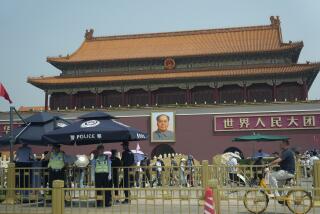Report Details Chinese Prison Brutality : Torture: Three severely punished for throwing paint on Mao portrait, rights group says.
- Share via
BEIJING — One of the dramatic incidents of the Tian An Men Square pro-democracy protests occurred May 23, 1989, when paint was thrown on the portrait of Chairman Mao Tse-tung that hangs on the Gate of Heavenly Peace.
Three young men from Hunan province have suffered greatly for that action, according to a 60-page report on torture in Chinese prisons released today by the London-based human rights organization Amnesty International. The report details dozens of specific cases, many of which involved extraordinary brutality.
In the defacing of Mao’s portrait, the three accused, who were arrested on the spot, “apparently refused to acknowledge their guilt and were reportedly subjected to severe torture and ill-treatment from the time of their arrest,” Amnesty International said.
After conviction for “counterrevolutionary” offenses, the three were sent to Hunan Provincial Prison No. 3 in the town of Lingling, the report said. Yu Zhijian, 27, a primary school teacher, was sentenced to life imprisonment; Yu Dongyue, 24, a fine arts editor for a newspaper, got a 20-year term, and Lu Decheng, 28, a bus company employee, was sentenced to 16 years, the report said.
Yu Zhijian and Yu Dongyue were subsequently held for more than two years in the “strict regime” section of Lingling prison, “which means punitive solitary confinement in particularly harsh conditions,” the report said. Lu reportedly spent six months in these conditions, it said. The cells “are dark and damp, with extremely deficient sanitation, and have no heating or ventilation, which makes them extremely cold in winter and unbearably hot in summer,” it said.
“By early 1992, Yu Zhijian was reported to have become extremely thin and to be in very poor condition; Yu Dongyue reportedly showed signs of mental disturbance and had lost control of some bodily functions,” the report continued.
Yu Dongyue and Lu were transferred to another prison early this year, while Yu Zhijian was still at Lingling in “strict regime” solitary confinement in April, the month when the last report was received about him, Amnesty International reported.
A kind of torture known as the “shackle board” was used against Peng Yuzhang, a retired Hunan University professor in his 70s, according to the report. Peng was arrested for taking part in a peaceful demonstration in Changsha during the nationwide 1989 protests, it said. After repeatedly complaining about his arrest and demanding to be released, he was handcuffed to the board for three months, according to the report.
A shackle board “consists of a wooden door laid flat on four short legs, with handcuffs fixed at each corner of the board,” the report said. “Prisoners are attached to the board with the arms and legs spread out. . . . A hole in the board allows evacuation of urine and excrement. Several cases have been reported of prisoners who were left shackled to the board continuously for several months, with some becoming mentally disturbed as a result.”
Peng was released from the shackle board in October, 1989, the report said. Within one month, he was moved from the Changsha No. 1 Detention Center, where the torture had been inflicted, and was forcibly committed to a psychiatric asylum. By early 1991, his friends and relatives had been without news of him for many months, the report added. Amnesty International said it does not know whether he is still alive.
The report also details incidents of torture, including beatings, electric shocks and use of the shackle board, against nine other protesters in Hunan province prisons. It provides details on about 20 Tibetans imprisoned in Lhasa for alleged support of Tibetan independence, 13 political prisoners tortured in Liaoning province, several prisoners in Shaanxi province, and two cases each in Shanghai, Beijing and Fujian province.
Sonam Dolkar, 26, a woman who escaped from Tibet after being released from prison, told an interviewer that three days after her arrest, four police officers began torturing her during interrogation at the Seitru Detention Center.
“They slapped and punched her, then stripped her naked and wrapped electric wires around her body, with the naked end of the wires touching her fingers,” the report said.
This woman said interrogation and torture continued every other day for six months. She also was beaten badly enough for two ribs to be broken, she said.
While the report focused on political prisoners, about whom information is more likely to be available, most torture victims are poorly educated criminal suspects, it said. The Chinese penal system places importance on acknowledgment of guilt, and torture is sometimes used to extract confessions that may or may not be true, it said.
Although Chinese law forbids torture, abuses continue largely because of the lack of legal safeguards for prisoners’ rights, the report said.
In the past, the Chinese government has acknowledged that torture is sometimes used to extract confessions, but it said that such incidents are rare and punished when reported.
More to Read
Sign up for Essential California
The most important California stories and recommendations in your inbox every morning.
You may occasionally receive promotional content from the Los Angeles Times.










